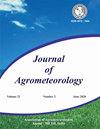Comparative evaluation of penalized regression models with multiple linear regression for predicting rapeseed-mustard yield: Weather-indices based approach
Q3 Agricultural and Biological Sciences
引用次数: 0
Abstract
Rapeseed-mustard (Brassica spp.) is one of the important edible oilseeds crops in India. The same level of weather condition impacts the growth and establishment of rapeseed-mustard plant differently in different stages of crop which lead to large intra-seasonal yield variations. Hence it is essential to give weightage to weekly weather conditions while fitting predictive model. In this present study, path-coefficient based weighted index was proposed along with existing unweighted and correlation based weighted index. The performance of penalized regression models viz. Ridge Regression, Least Absolute Shrinkage and Selection Operator (LASSO) and Elastic Net (ENET) were compared with Multiple Linear Regression (MLR) for predicting rapeseed-mustard yield using weather-indices. The results revealed that the path-coefficient based weighting of weather parameters to the yield were stable than correlation based weighted-indices. Path-coefficient based weighted indices of maximum temperature, minimum temperature and windspeed were important variables in projection of yield. The performance of MLR was poor during validation of model due to overfitting issue. The performance of penalized models was stable in both calibration and validation of the model. The LASSO and ENET models that accompanied with coefficient shrinkage and variable selection were found to be the best fitted models for predicting Rapeseed-Mustard yield.惩罚回归模型与多元线性回归预测油菜籽-芥菜产量的比较评价:基于天气指数的方法
油菜是印度重要的食用油料作物之一。同一气候条件对油菜植株生长和结实的影响在作物的不同生育期不同,造成了较大的季节内产量变化。因此,在拟合预测模型时,必须考虑每周的天气状况。本研究在现有的未加权和相关加权指标的基础上,提出了基于路径系数的加权指标。比较了岭回归、最小绝对收缩和选择算子(LASSO)和弹性网(ENET)等惩罚回归模型与多元线性回归(MLR)在利用气象指数预测油菜籽-芥菜产量方面的表现。结果表明,基于路径系数的气象参数权重对产量的影响比基于相关加权指数的影响更稳定。基于路径系数的最高气温、最低气温和风速加权指标是产量预测的重要变量。在模型验证过程中,由于过度拟合问题,MLR的性能较差。惩罚模型的性能在模型的标定和验证中都是稳定的。结果表明,LASSO和ENET模型与系数收缩和变量选择相结合是预测油芥产量的最佳拟合模型。
本文章由计算机程序翻译,如有差异,请以英文原文为准。
求助全文
约1分钟内获得全文
求助全文
来源期刊

Journal of Agrometeorology
农林科学-农艺学
CiteScore
1.40
自引率
0.00%
发文量
95
审稿时长
>12 weeks
期刊介绍:
The Journal of Agrometeorology (ISSN 0972-1665) , is a quarterly publication of Association of Agrometeorologists appearing in March, June, September and December. Since its beginning in 1999 till 2016, it was a half yearly publication appearing in June and December. In addition to regular issues, Association also brings out the special issues of the journal covering selected papers presented in seminar symposia organized by the Association.
 求助内容:
求助内容: 应助结果提醒方式:
应助结果提醒方式:


